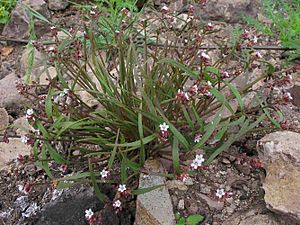Serpentine springbeauty facts for kids
Quick facts for kids Serpentine springbeauty |
|
|---|---|
 |
|
| Scientific classification | |
| Genus: |
Claytonia
|
| Species: |
exigua
|
The Claytonia exigua, also known as serpentine springbeauty or pale claytonia, is a small and interesting wildflower. It belongs to the Montiaceae plant family. This plant grows naturally in western North America. You can find it from British Columbia in Canada, down through Idaho, and all the way to California in the United States. It likes to grow in many different places, especially in areas with special serpentine soils.
About the Serpentine Springbeauty
The Claytonia exigua is an annual plant, which means it completes its whole life cycle in just one year. It's a herb, so it has soft, green stems instead of woody ones. This plant grows in a small patch with stems that stand up straight or lean a little. They can reach about 15 centimeters (about 6 inches) tall.
Leaves and Stems
The leaves of the serpentine springbeauty are thick. The ones near the bottom of the plant are long and thin, almost like fingers. Higher up on the stem, the leaves change shape. They can look like a crescent moon or even a small disc. The whole plant is smooth and waxy, without any hairs. Its color can vary from green to pinkish, grayish, or even brownish.
Flowers and Fruit
The plant's flowers grow in a group called an inflorescence. Several flowers hang down on small stalks called pedicels. As the plant grows and makes fruit, these stalks stand up straight. Each flower has five petals that are a few millimeters long. These petals can be pink, white, or white with pink streaks.
After the flowers bloom, the plant produces a small fruit. This fruit is a tiny capsule that is less than three millimeters long. Inside the capsule, you'll find a few very small seeds.

